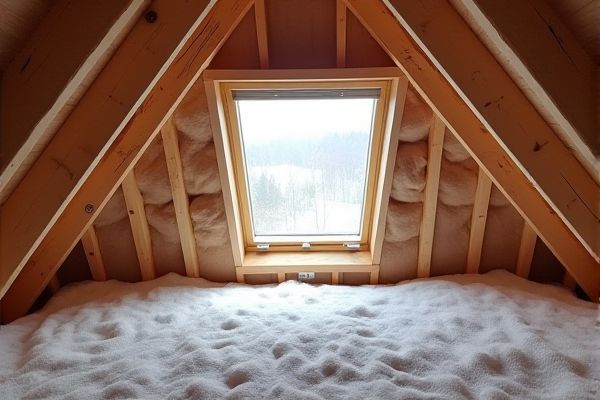
An insulated attic hatch significantly reduces heat loss and improves energy efficiency by creating a thermal barrier between your conditioned living space and the unconditioned attic. Understanding the differences between insulated and uninsulated attic hatches can help you make the best choice for your home's comfort and energy savings--read on to discover more.
Table of Comparison
| Feature | Insulated Attic Hatch | Uninsulated Attic Hatch |
|---|---|---|
| Energy Efficiency | High - reduces heat loss and air infiltration | Low - allows heat transfer and drafts |
| Thermal Barrier | Provides an effective thermal barrier | No thermal barrier present |
| Cost | Higher upfront cost due to added insulation | Lower initial cost |
| Installation | Requires proper sealing and insulation fit | Simple installation |
| Condensation Control | Reduces risk of condensation and moisture buildup | Higher risk of moisture problems |
| Comfort | Improves indoor temperature consistency | Can lead to drafts and temperature fluctuations |
| Energy Savings | Significant savings on heating and cooling costs | No significant energy savings |
Introduction to Attic Hatches
Insulated attic hatches significantly improve energy efficiency by minimizing heat loss through the attic access point, maintaining consistent indoor temperatures and reducing heating and cooling costs. Uninsulated attic hatches allow warm or cool air to escape, creating drafts that increase energy consumption and decrease home comfort. Investing in an insulated attic hatch with proper weatherstripping enhances thermal performance and contributes to overall home energy savings.
What Is an Insulated Attic Hatch?
An insulated attic hatch is a specially designed access point covered with material that reduces heat loss and prevents drafts, significantly improving your home's energy efficiency. Unlike uninsulated attic hatches, which allow cold or hot air to infiltrate through gaps, insulated hatches maintain consistent attic temperature and reduce utility bills. Proper installation of an insulated attic hatch ensures a tighter seal and enhanced thermal insulation compared to standard uninsulated options.
Uninsulated Attic Hatch: Definition and Features
An uninsulated attic hatch is a basic access panel that lacks thermal insulation, allowing significant heat transfer between the living space and the attic. Typically made from wood or lightweight materials, these hatches often feature no sealing or weatherstripping, leading to energy inefficiency and increased utility costs. Their primary function is access rather than energy conservation, making them unsuitable for homes prioritizing thermal performance and comfort.
Energy Efficiency Comparison
An insulated attic hatch significantly improves energy efficiency by reducing heat transfer between your living space and the attic, maintaining consistent indoor temperatures and lowering heating and cooling costs. Uninsulated attic hatches allow air leakage and thermal bridging, resulting in heat loss during winter and heat gain in summer. Upgrading to an insulated hatch enhances your home's overall thermal performance and promotes long-term energy savings.
Impact on Home Heating and Cooling
An insulated attic hatch significantly reduces heat transfer between your living space and the attic, enhancing energy efficiency and maintaining consistent indoor temperatures. Uninsulated hatches allow heat to escape in winter and enter in summer, increasing your heating and cooling costs by forcing HVAC systems to work harder. Proper insulation around attic access points is crucial for improving your home's overall thermal performance and lowering utility bills.
Moisture and Condensation Control
An insulated attic hatch significantly reduces moisture buildup and condensation by maintaining a consistent temperature barrier between your living space and the attic, preventing warm, moist air from entering and cooling rapidly. Unlike uninsulated hatches, insulated ones help control humidity levels, reducing the risk of mold growth and structural damage caused by trapped moisture. Proper moisture and condensation control in your attic improves indoor air quality and extends the life of your roof and insulation materials.
Air Leakage and Indoor Comfort
An insulated attic hatch significantly reduces air leakage by creating a tight barrier, preventing warm or cool air from escaping your living spaces. This improved air sealing enhances indoor comfort by maintaining consistent temperatures and reducing drafts throughout your home. Choosing an insulated option minimizes energy loss and contributes to a more efficient heating and cooling system.
Cost Differences and ROI
An insulated attic hatch typically costs more upfront compared to an uninsulated one, with prices varying based on materials and installation complexity. However, the energy savings from reduced heat loss in insulated hatches offer a higher return on investment (ROI) by lowering heating and cooling bills over time. You benefit from improved home energy efficiency and increased comfort, making the initial cost difference worthwhile for long-term savings.
Installation Considerations
Installing an insulated attic hatch requires careful sealing and addition of foam insulation panels or pre-insulated covers to minimize air leakage and maintain energy efficiency. Uninsulated attic hatches are simpler to install but can lead to significant heat loss and increased energy costs due to poor thermal performance. Proper weatherstripping and airtight installation methods on insulated hatches enhance overall home comfort by reducing drafts and preventing heat transfer between living spaces and the attic.
Which Attic Hatch Is Right for Your Home?
Choosing the right attic hatch depends on your home's insulation needs and energy efficiency goals. Insulated attic hatches reduce heat loss, improve temperature regulation, and lower energy bills by providing a thermal barrier. Uninsulated hatches may be suitable for unconditioned spaces but typically lead to increased energy costs and less comfortable living areas.
 homyna.com
homyna.com